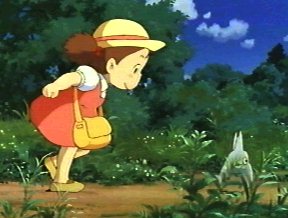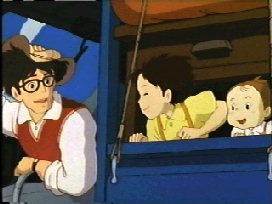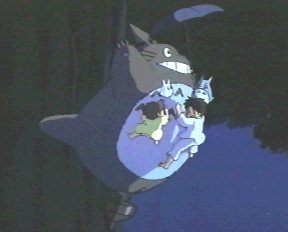
|
Mei chases a small totoro who
has been drinking Everclear.
|
In general, we're pretty excited about the fact that Disney has elected to release the films of Hayao Miyazaki in the U.S. Miyazaki's wondrous animated movies have long awaited a widespread release in the States, and Disney is the kind of company that can and hopefully will spend the needed time and money to translate and dub the films properly into English. Back in January when we reviewed Laputa, someone mentioned the fact that one of Miyazaki's films is already widely available in the U.S.: My Neighbor Totoro. The movie, more commonly known as simply Totoro, is not only well-animated, it was also given the royal treatment and is widely regarded as one of the best anime dubs ever.
What this means, of course, is that Disney will probably be making their own dub, which may be inferior to the existing print, dubbed by Carl Macek and released by Fox Video. (Hint: Go out and pick up a copy before they disappear in favor of the Disney version, just in case.) If this happens, Disney's distribution of a Miyazaki film may well have a negative effect. In any case, Totoro has long been one of our favorite animated films, and this review is past due.
Totoro opens sometime in the 1950's in a small Japanese province, home to rice paddies and country roads. Down one of those country roads comes the moving truck of the Kusakabe family, consisting of two young girls, Mei and Satsuki, and their father, Tatsuo. They are moving to this part of Japan because the girls' mother, who suffers from an unnamed illness, has moved into a nearby hospital specializing in the treatment of the disease. The girls arrive at the house to find it haunted by "dust bunnies," little black fuzzballs who like to live in abandoned houses.

|
"Now kids, you should never stick your head
out the window like this because you might
be decapit--"
|
Although the dust bunnies leave shortly thereafter, there are more forest creatures for the girls to meet -- namely, the totoros. A totoro (emphasis on the first syllable) is a forest spirit, invented by Miyazaki as a combination of several different animals. They come in all sizes, but the one we are most concerned with as viewers is O Totoro, or "Big Totoro." The girls encounter Totoro several times over the course of the film, and he acts as a sort of guardian to the girls while their mother begins to recuperate.
As movies go, Totoro is not a tightly-plotted adventure. The first half-hour has been described as "boring" by some of our less favorite movie critics (Siskel! Gene Siskel!), and granted, it's not riveting. But the payoff of sheer delight after those opening scenes would be worth sitting through twice the amount of the slower footage. We've found that a lot of critics perceive Totoro as "gooey" child fare, but we perceive those critics as jaded fatheads who don't remember what it's like to be a kid.
Totoro was released by Fox at the same time that Disney inflicted Pocahantas on us, and the two films both have enviromental themes, Pocahantas' stemming from the pop version of Native American lore, Totoro's stemming from a curiously literal interpretation of some elments found in Shinto mythology. Totoro, despite featuring plenty of ghosts and spirits, has a more realistic view of nature and our relationship with it. For instance, the filmmakers acknowledge the fact that nature isn't all cuddly animals, evidenced by the fact that there are some scary elements incorporated in the design of the large Totoro. His voice, when he uses it, is always a deafening, tree-shaking roar. In one scene, while sleeping, he seems to be dangerously close to biting little Mei's head off. The events in My Neighbor Totoro imply that although nature seldom intends to hurt people, it can be dangerous and should be treated with respect.

|
Totoro is actually the story of a
Macy's Thanksgiving Day parade float
gone horribly wrong.
|
Totoro's most remarkable feature is its ability to put the viewer behind the eyes of these children. Throughout the movie the girls' mother is in the hospital, for reasons never explained. It seems safe to assume that she has tuberculosis (as was later explained by Miyazaki in an interview), but it is never stated in the movie itself. By not telling you what is wrong with her, the films forces you into the position of a young child who can't yet understand the complexities of medicine and disease. Why is mommy in the hospital? Mei and Satsuki don't really know, and neither do we, the viewers.
One of the other reasons for our love of Totoro is the quality of the aforementioned English dub. Every detail is perfect, down to the spontaneous bursts of laughter from Mei and her muffled protests through sobs later in the film. Problematic Japanese idioms are nicely glossed over, but important cultural details are not omitted. It is a model of quality translation and voice acting.
A final testament to My Neighbor Totoro's appeal is the fact that Chris has given copies as gifts on many different occasions, and to many different people adults and children. All of these recipients have responded with great enthusiasm about the movie after seeing it, and the parents of those children who own copies have remarked about their own reactions to the movie. My Neighbor Totoro is a gem of a film, and is probably only overshadowed by other Miyazaki films -- like Laputa, for its grand adventure, or Kiki's Delivery Service, for its charming story and heroine. Still, Totoro will inspire more viewers to buy stuffed toys.









